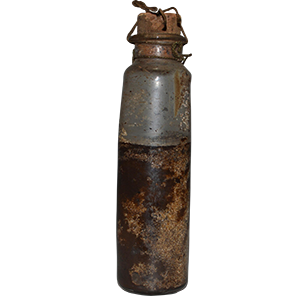 The mixture of saline particles and earth stored within this stoppered bottle originated in Guyana, located along the northern edge of South America. Robert Hermann Schomburgk, a Prussian-born explorer, donated the specimen to the British Museum in 1836, having acquired it during his travels in Guyana, then still a British colony. The archival trail surrounding this artifact is sparse, divulging only that the saline particles were “used as salt.” What that use might have entailed—seasoning food, preserving food or scientific specimens, dressing wounds, or something more spiritual—remains a mystery. What is certain, however, is that salt harbored manifold meanings and functions in this contentious landscape, inhabited alike by imperial surveyors, a complex web of Indigenous communities, and enslaved Africans on the brink of liberation.
The mixture of saline particles and earth stored within this stoppered bottle originated in Guyana, located along the northern edge of South America. Robert Hermann Schomburgk, a Prussian-born explorer, donated the specimen to the British Museum in 1836, having acquired it during his travels in Guyana, then still a British colony. The archival trail surrounding this artifact is sparse, divulging only that the saline particles were “used as salt.” What that use might have entailed—seasoning food, preserving food or scientific specimens, dressing wounds, or something more spiritual—remains a mystery. What is certain, however, is that salt harbored manifold meanings and functions in this contentious landscape, inhabited alike by imperial surveyors, a complex web of Indigenous communities, and enslaved Africans on the brink of liberation.
Schomburgk explored Guyana for the Royal Geographical Society and subsequently the British Government in the 1830s and 1840s. While he would achieve fame and knighthood by surveying the boundaries of the colony, the resulting “Schomburgk Line” between Guyana and Venezuela would be contentiously disputed in the Venezuelan crisis of 1895 and onward. Despite the imperial ambitions of his sojourns in South America, Schomburgk was fundamentally a hungry body in motion. Salt, in particular, was never far from his mind—as evident in his saline-centered writings from Guyana—but often, maddeningly, just out of reach.
In European scientific cosmologies, salt represented “nature’s generative powers” and “ingenuity” in the early modern period, as described by Richard Oosterhoff. But it also had a range of practical uses, especially to season or preserve food. European reliance on salt can be gleaned from the lengths to which Schomburgk rued its absence. When his surveying party suffered a canoeing accident, for example, he wrote: “Fortunately no human life was lost, but of the cargo, which consisted of our kitchen apparatus and the little stock of salt so precious to a traveller through the moist regions, nothing whatever was saved, and I was obliged to adopt for the remainder of the journey the Indian fashion of eating” (i.e., one lacking salt and European utensils). Years later, Schomburgk would still look back on that moment with regret and lament their loss of the “comfort” of “a grain of salt.” It would be just one of many times his party faced the depletion of their salt reserves. Such salt obsession could reach heights of desperation among weary travelers. At one point, Schomburgk’s men made a broth out of a crane, which “promised a delicious soup,” but they “unfortunately…spoiled it” by adding gunpowder, after having endured several saltless days and hoping the saltpeter in the gunpowder would be a worthy substitute. Schomburgk wrote: “The taste of the nitre and sulphur perfectly spoiled an entertainment so eagerly anticipated by our hungry stomachs.”
Beyond salt’s alimentary function, it also played a role in European medicine on the go. In 1838, one of Schomburgk’s comrades was bitten by a rattlesnake, at which point Schomburgk “ordered the wound, which was over the artery of the leg, to be sucked alternately by two powerful men, and well rubbed with salt and sweet oil, which were also given internally.” Given its range of applications, salt that could be acquired on the journey was cherished, and frequently showed Schomburgk’s dependence on Indigenous communities. In 1839, he wrote: “we procured what, to us, was a great prize—a small calabash full of salt from some Guinaus,” people of Arawak descent. Schomburgk often made note of when Indigenous people, such as the Macushi and Wapisiana, collected salt from the savannah during his travels. Could the bottle of salt he donated to the British Museum represent a last-ditch effort to make his local environment yield the comforts of home?
Given Schomburgk’s voluminous writings, speculations about the vial of salt too easily skew toward European voices and uses. What more silent meanings might it have held for other groups? Schomburgk noted the near-absence of salt in the diets of various Indigenous groups he met throughout Guyana; eighteenth-century plantation physician Edward Bancroft similarly wrote of his time in Dutch Guiana: “The Indians…use but little Salt with their food.” Recent ethnobotanical research, however, shows that salt plays a role in treating ailments among numerous Indigenous communities throughout the region. When used in combination with native plants, salt soothes troubles ranging from wounds to coughs to wheezing in babies to fungal diseases like ringworm. Yet, such research must also take into account the potential for syncretism among centuries-old Indigenous Guyanese medicine, European influences, African diasporic traditions that shaped local plantlore in the midst of displacement, as well as the potential infusion of Chinese and Indian plant knowledge given the arrival of indentured Asian laborers in the region after the full abolition of chattel slavery in Guyana in 1838.
Indeed, salt took on much darker meanings in the context of Atlantic slavery, which itself required a material passage through the salty waters of the ocean—a reverse baptism, in some sense, from freedom to slavery. Moreover, rock salt and sea salt were used as currency to purchase Africans for enslavement, along with other specimens-turned-coinage like cowrie shells and red coral. And as Michele Speitz has argued, historians frequently overlook the harvesting of salt and its subsequent trade, which made up a significant portion of the slave economy in the West Indies and enacted a devastating physical toll on laboring enslaved bodies.
On a more metaphysical level, salt became synonymous with capture, leading to a widespread salt taboo among the enslaved in Guyana and elsewhere throughout the Americas. According to Coromantee, Kongo, and other African oral traditions centered around the diaspora in Guyana, salt made the body heavy. It thus prevented slaves from flying through the air to freedom—a feat recorded in oral histories, which documented mass groups of enslaved Africans launching from the decks of slave ships or the shores of the New World. Salt proved a material barrier to this miraculous, hoped-for return to Africa out of bondage, and a suppressant of liberatory occult powers. By abstaining from salted goods—a difficult refusal given the preponderance of salted fish and salted meat offered on ships during the Middle Passage—captured Africans worked to retain their potential for magical flight.
Ultimately, salt is a custodian of history, one with particular relevance to this exhibition. Ernest Hemingway used salt to preserve the albacore tuna featured on this site, and salt very likely played a role in the incredible persistence of mummified skin on the head of the extinct dodo specimen also described herein. Salt as an archivist for science and history holds true of early modern Guyana, as well. Edward Bancroft wrote of eighteenth-century attempts to preserve “the most curious Birds” as scientific specimens in the region: “several persons in this Colony advantageously employ themselves, with their slaves and dependents, in killing and preserving Birds for the Cabinets of Naturalists” by filling the bodies of the birds with salt and alum, in a manner “unknown in Europe.” Salt was ever, then, a multivalent food object in the contact zones of the Americas—perhaps all the more so in Guyana and its borderlands, the original homeland of this salt of the earth.
Image: “Sample of earth containing saline particles, used as salt; contained in glass bottle,” donated from Guyana by Robert Hermann Schomburgk, pre-1836, British Museum (Am1836,0901.53). © The Trustees of the British Museum.
 This article was written by Whitney Barlow Robles. For more information about her work and her other contributions to The Kitchen in the Cabinet click here.
This article was written by Whitney Barlow Robles. For more information about her work and her other contributions to The Kitchen in the Cabinet click here.
References
Austin, Daniel F. and Godfrey R. Bourne. “Notes on Guyana’s Medical Ethnobotany.” Economic Botany 46, no. 3 (1992): 293–298.
Bancroft, Edward. An Essay on the Natural History of Guiana, in South America. London: 1769. 325, 183.
Burnett, Graham. Masters of All They Surveyed: Exploration, Geography, and a British El Dorado. Chicago: The University of Chicago Press, 2000.
Oosterhoff, Richard. “Ingenious Materials: Salts as Material Metaphor.” In Secrets of Craft and Nature in Renaissance France. A Digital Critical Edition and English Translation of BnF Ms. Fr. 640. Edited by Making and Knowing Project, Pamela H. Smith, Naomi Rosenkranz, Tianna Helena Uchacz, Tillmann Taape, Clément Godbarge, Sophie Pitman, Jenny Boulboullé, Joel Klein, Donna Bilak, Marc Smith, and Terry Catapano. New York: Making and Knowing Project, 2020. https://edition640.makingandknowing.org/#/essays/ann_324_ie_19.
Schomburgk, R. H. “Journey from Fort San Joaquim, on the Rio Branco, to Roraima, and Thence by the Rivers Parima and Merewari to Esmeralda, on the Orinoco, in 1838–9.” The Journal of the Royal Geographical Society of London 10 (1840): 213 and 239.
Schomburgk, Robert H. “Journal of an Expedition from Pirara to the Upper Corentyne, and from Thence to Demerara.” The Journal of the Royal Geographical Society of London 15 (1845): 92 and 95.
Schuler, Monica. “Liberated Central Africans in Nineteenth-Century Guyana.” Harriet Tubman Seminar, York University, January 25, 2000. 17, 22, 23.
Schuler, Monica. “Enslavement, the Slave Voyage, and Astral and Aquatic Journeys in African Diaspora Discourse.” In Africa and the Americas: Interconnections During the Slave Trade. Edited by José C. Curto and Renée Soulodre-La France. Trenton, NJ: Africa World Press, 2005. 189–190 and 197–198.
Speitz, Michele. “Blood Sugar and Salt Licks: Corroding Bodies and Preserving Nations in The History of Mary Prince, a West Indian Slave, Related by Herself.” Romantic Circles (October 2011). https://romantic-circles.org/praxis/circulations/HTML/praxis.2011.speitz.html#1.